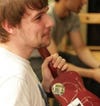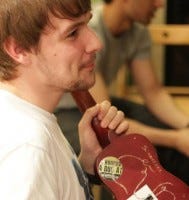
Featured Blog | This community-written post highlights the best of what the game industry has to offer. Read more like it on the Game Developer Blogs or learn how to Submit Your Own Blog Post
Trying and failing. From Industry to Indie and out the other side.
When I left Crytek in the Autumn of 2013 to go independent I felt prepared. I'd done my homework, written a business plan and got funding. The one thing I hadn't planned for was making a boring game, and the crisis of confidence that quickly ensued...

This was originally posted on antitranslate.com on Monday 29th Feb 2016.
Beyond the Infinite is a non-competitive co-operative music platformer or maybe, Beyond the Infinite is a fast-paced puzzle racer with musical elements, no wait, Beyond the Infinite is a competitive infinite runner where the player influences and creates the audio through their movements and actions… Actually Beyond the Infinite is not quite any of these things, yet. Beyond the Infinite is a half finished independent game that features bits and pieces of the above. I’ve been intermittently working on it now since late 2013. Development has been tumultuous and difficult.
After nearly three years as a designer at Crytek UK working on the Crysis series and six challenging months on the soon to be released Homefront: The Revolution I figured I knew enough to give up gainful employment in favour of a life of destitution starting my own independent game development studio, setting out to run it in a model similar to a record label with short games consistently released every few months. I wrote a (naïve) business plan, got some funding and started developing.
I don’t remember exactly where the idea came from, but I do remember the moment that inspired it. I was sat on the balcony of the Crytek company apartment with my laptop, headphones on, doobie in hand, watching Milkdrop while listening to ‘The Tide’ by Noisa and 'Black and Red' by Jon Hopkins. What really inspired me was the idea of music as a narrative. While I wasn’t listening to them at the time both 'Insides’ by Jon Hopkins, and the brilliantly executed 'War of the Worlds in Dubstep’ by ertwenpeller gave the concept some additional weight. To me it appeared to be unexplored in games bar the odd exception such as Rez or Zone Mode in Wipeout HD.
The seed was sown and I spent the next couple of years mulling over how to marry satisfying game-like interaction, music, and visuals. I figured to get that sense of synaesthesia the gameplay and audio had to be fundamentally linked, every action in the game would create or influence some aspect of the audio.
But when I sat down in front of Unity on my first official day of self-employment I wasn’t thinking about any of this. I was trying to stick to my plan of releasing every three or four months so that meant keeping it simple. I didn’t know how to code and didn’t know how to use Unity beyond a few tutorials so my scope was limited. After about three weeks I’d come up with this:
It’s super simple and pretty fun, but basic and I was ambitious. I could have - and probably should have - spent the next couple of months shining it up into something presentable and released it. I didn’t though, and instead the simple easy to complete project morphed into something much more challenging. I figured I could take the prototype and improve it by making it the vehicle for my synaesthesia concept.
In my mind it seemed to fit. The player would be flying through these tubes having to perform platforming actions as in the prototype, but the actions would be musical samples. When you needed to jump a kick drum sample would be at exactly the right place, if you needed to duck here comes a snare sample, etc. The samples would be positioned so a pre-defined loop would be completed as you jumped, ducked and dodged around the tunnel. The problem was it just didn’t work. It wasn’t fun and it didn’t invoke any sense of synaesthesia. I don’t know how many iterations I did to try and 'find the fun’, but none of them really ticked the right boxes.

Just some of the many different versions.
Having spent six fruitless months with the game my confidence was shot and I remember having a meeting with Iain Simons and Jonathan Smith of Gamecity about the project. This is a video of the build I showed them:
They were far from blown away, but I think they could see some potential. They particularly liked the idea that it could be transformed into some kind of event or installation piece. However, the conclusion of the meeting was that I’d need to spend another six months on it at least to deliver.
There were two problems stopping that from happening. Firstly my funding was running dry; I’d need to invest more money in the project if I wanted to take it further. Secondly, and more importantly, I’d stopped believing in the game. I wasn’t convinced it could be made into the thing I wanted to make it into, or that I had the ability to do it. Admitting this at the time was one of the most difficult things I’ve had to do. The game represented something much larger. It was my dream of being independent, it was my freedom.
Around this time I got a full-time contract at Ubisoft. I worked there for nine months on The Division and during that time I didn’t once look at Beyond the Infinite.
It was a change in personal circumstances that brought me back to Nottingham. I had an offer to go back to what I knew at Crytek (now Deep Silver Dambuster Studios) or be part of a research project at the University of Nottingham developing games as medical treatments. I went for the research project and have been there now since April 2015. Not working in the games industry gave me the time, space and energy to start thinking about Beyond the Infinite again.
I started toying around with audio/visual stuff in Unity to get reacquainted with the tools and before I knew it I was enjoying developing again.
I had unfinished business with Beyond the Infinite. It was August when I decided I was going to restart the project from scratch. I figured out my mistakes and this time it was getting done right. One of the main reasons I couldn’t make it work before was because the audio was leading the gameplay. The audio determined the pacing and how the levels were constructed. This time I was going to build a fun game first, and not let the sound take precedence. It’s still an important aspect of the project, but it’s not the main one.
I’ll show more of the project and the process of making it in the coming weeks and months. For now though I’ll leave you with my final description: Beyond the Infinite is a frenetic gravity-bending aural journey, and I’m going to finish it.
Follow Anti-translate on your platform of choice to keep up to date with the latest developments.
Read more about:
Featured BlogsAbout the Author(s)
You May Also Like







.jpeg?width=700&auto=webp&quality=80&disable=upscale)








